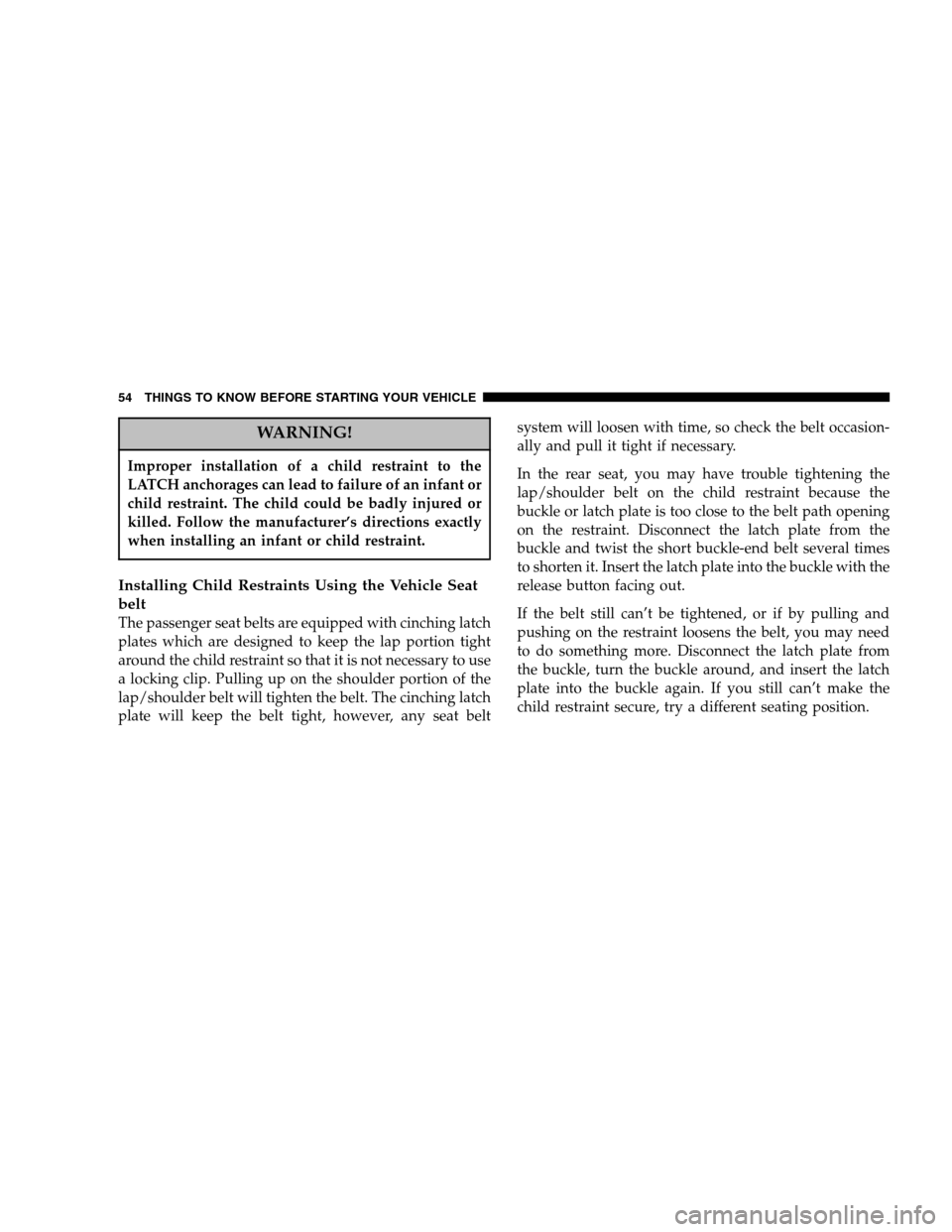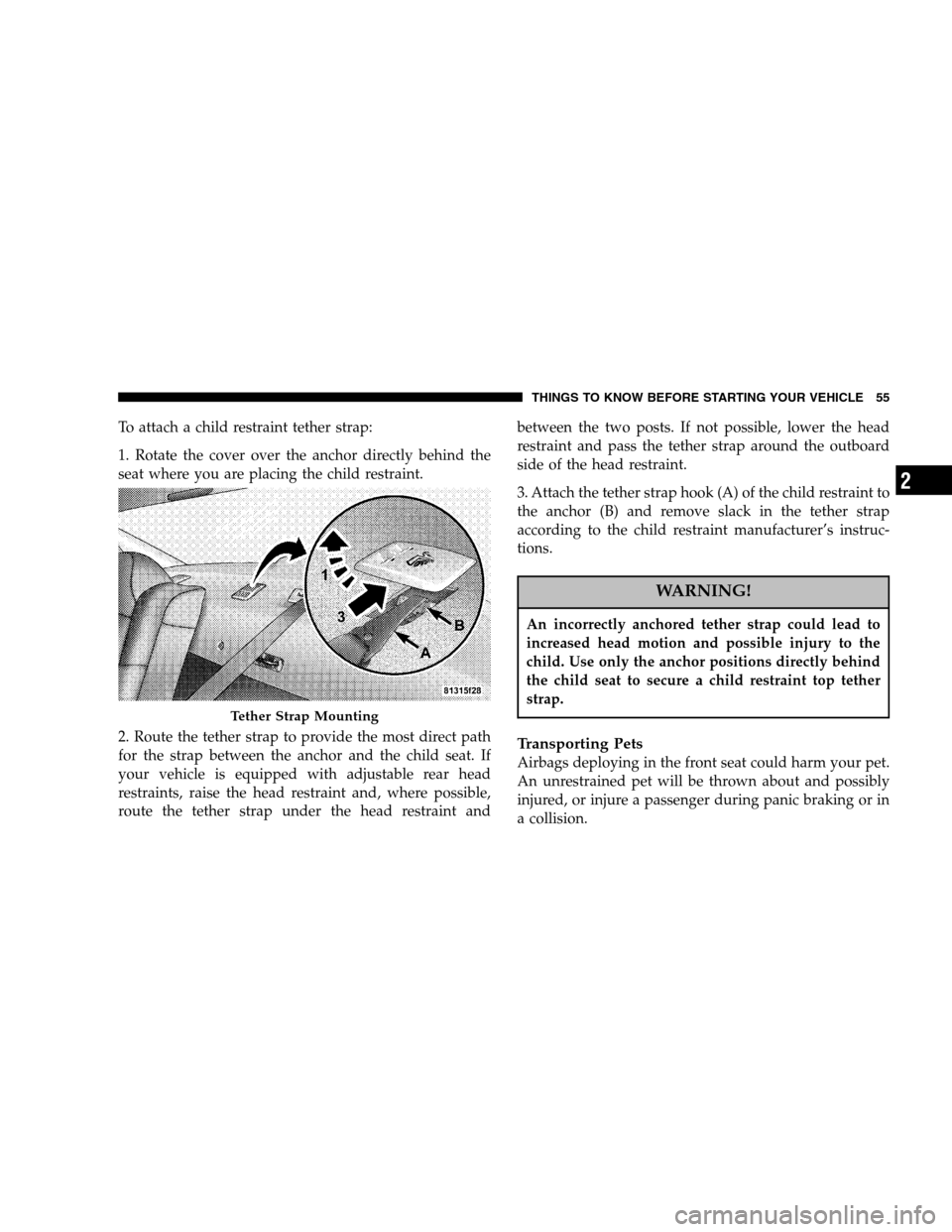2005 CHRYSLER 300 SRT child restraint
[x] Cancel search: child restraintPage 51 of 320

•The restraint must be appropriate for your child’s
weight and height. Check the label on the restraint for
weight and height limits.
•Carefully follow the instructions that come with the
restraint. If you install the restraint improperly, it may
not work when you need it.
•Buckle the child into the seat according to the child
restraint manufacturer’s directions.
•When your child restraint is not in use, secure it in the
vehicle with the seat belt or remove it from the vehicle.
Do not leave it loose in the vehicle. In a sudden stop or
collision, it could strike the occupants or seat backs
and cause serious personal injury.
NOTE:For additional information refer to
www.seatcheck.org or call 1–866–SEATCHECK.
Older Children and Child Restraints
Children who weigh more than 20 lbs (9 kg) and who are
older than one year can ride forward-facing in the
vehicle. Forward-facing child seats and convertible child
seats used in the forward-facing direction are for children
who weigh 20 to 40 lbs (9 to 18 kg) and who are olderthan one year. These child seats are also held in the
vehicle by the lap/shoulder belt or the LATCH child
restraint anchorage system. (See the LATCH — Child
Seat Anchorage System Section.)
The belt-positioning booster seat is for children weighing
more than 40 lbs (18 kg), but who are still too small to fit
the vehicle’s seat belts properly. If the child cannot sit
with knees bent over the vehicle’s seat cushion while the
child’s back is against the seat back, they should use a
belt-positioning booster seat. The child and belt-
positioning booster seat are held in the vehicle by the
lap/shoulder belt.
Children Too Large For Booster Seats
Children who are large enough to wear the shoulder belt
comfortably, and whose legs are long enough to bend
over the front of the seat when their back is against the
seat back, should use the lap/shoulder belt in a rear seat.
•Make sure that the child is upright in the seat.
•The lap portion should be low on the hips and as snug
as possible.
THINGS TO KNOW BEFORE STARTING YOUR VEHICLE 51
2
Page 52 of 320

•Check belt fit periodically. A child’s squirming or
slouching can move the belt out of position.
•If the shoulder belt contacts the face or neck, move the
child closer to the center of the vehicle. Never allow a
child to put the shoulder belt under an arm or behind
their back.
LATCH — Child Seat Anchorage System (Lower
Anchors and Tether for CH ildren)
Your vehicle’s rear seat is equipped with the child restraint
anchorage system called LATCH. The LATCH system pro-
vides for the installation of the child restraint without using
the vehicle’s seat belts, instead securing the child restraint
using lower anchorages and upper tether straps from the
child restraint to the vehicle structure.
LATCH-compatible child restraint systems are now avail-
able. However, because the lower anchorages are to be
introduced over a period of years, child restraint systems
having attachments for those anchorages will continue to
also have features for installation using the vehicle’s seat
belts. Child restraints having tether straps and hooks for
connection to the top tether anchorages have been avail-
able for some time. For some older child restraints, manychild restraint manufacturers offer add-on tether strap
kits or retro-fit kits. You are urged to take advantage of all
the available attachments provided with your child re-
straint in any vehicle.
All three rear seating positions have lower anchorages
that are capable of accommodating LATCH-compatible
child seats. You shouldNEVERinstall LATCH-
compatible child seats such that two seats share a com-
mon lower anchorage.
LATCH Anchorages
52 THINGS TO KNOW BEFORE STARTING YOUR VEHICLE
Page 53 of 320

Installing the LATCH-Compatible Child Restraint
System
We urge that you carefully follow the directions of the
manufacturer when installing your child restraint. Not all
child restraint systems will be installed as described here.
Again, carefully follow the installation instructions that
were provided with the child restraint system.
The rear seat lower anchorages are round bars,
located at the rear of the seat cushion where it
meets the seat back. The location of the lower
anchorages are identified by a symbol on the
seat back. You will easily feel them if you run your finger
along the intersection of the seatback and seat cushion
surfaces.
In addition, there are tether strap anchorages
behind each rear seating position located in the
panel between the rear seat back and the rear
window. These tether strap anchorages are
under a plastic cover with this symbol on it.
Many, but not all restraint systems will be equipped with
separate straps on each side, with each having a hook or
connector for attachment to the lower anchorage and ameans of adjusting the tension in the strap. Forward-
facing toddler restraints and some rear-facing infant
restraints will also be equipped with a tether strap, a
hook for attachment to the tether strap anchorage and a
means of adjusting the tension of the strap.
You will first loosen the adjusters on the lower straps and
on the tether strap so that you can more easily attach the
hooks or connectors to the vehicle anchorages. Next
attach the lower hooks or connectors over the top of the
seat cover material. Then rotate the tether anchorage
cover directly behind the seat where you are placing the
child restraint and attach the tether strap to the anchor-
age, being careful to route the tether strap to provide the
most direct path between the anchor and the child
restraint. If your vehicle is equipped with adjustable rear
head restraints, raise the head restraint and, where pos-
sible, route the tether strap under the head restraint and
between the two posts. If not possible, lower the head
restraint and route the tether strap around the outboard
side of the head restraint. Finally, tighten all three straps
as you push the child restraint rearward and downward
into the seat, removing slack in the straps according to
the child restraint manufacturer’s instructions.
THINGS TO KNOW BEFORE STARTING YOUR VEHICLE 53
2
Page 54 of 320

WARNING!
Improper installation of a child restraint to the
LATCH anchorages can lead to failure of an infant or
child restraint. The child could be badly injured or
killed. Follow the manufacturer’s directions exactly
when installing an infant or child restraint.
Installing Child Restraints Using the Vehicle Seat
belt
The passenger seat belts are equipped with cinching latch
plates which are designed to keep the lap portion tight
around the child restraint so that it is not necessary to use
a locking clip. Pulling up on the shoulder portion of the
lap/shoulder belt will tighten the belt. The cinching latch
plate will keep the belt tight, however, any seat beltsystem will loosen with time, so check the belt occasion-
ally and pull it tight if necessary.
In the rear seat, you may have trouble tightening the
lap/shoulder belt on the child restraint because the
buckle or latch plate is too close to the belt path opening
on the restraint. Disconnect the latch plate from the
buckle and twist the short buckle-end belt several times
to shorten it. Insert the latch plate into the buckle with the
release button facing out.
If the belt still can’t be tightened, or if by pulling and
pushing on the restraint loosens the belt, you may need
to do something more. Disconnect the latch plate from
the buckle, turn the buckle around, and insert the latch
plate into the buckle again. If you still can’t make the
child restraint secure, try a different seating position.
54 THINGS TO KNOW BEFORE STARTING YOUR VEHICLE
Page 55 of 320

To attach a child restraint tether strap:
1. Rotate the cover over the anchor directly behind the
seat where you are placing the child restraint.
2. Route the tether strap to provide the most direct path
for the strap between the anchor and the child seat. If
your vehicle is equipped with adjustable rear head
restraints, raise the head restraint and, where possible,
route the tether strap under the head restraint andbetween the two posts. If not possible, lower the head
restraint and pass the tether strap around the outboard
side of the head restraint.
3. Attach the tether strap hook (A) of the child restraint to
the anchor (B) and remove slack in the tether strap
according to the child restraint manufacturer’s instruc-
tions.
WARNING!
An incorrectly anchored tether strap could lead to
increased head motion and possible injury to the
child. Use only the anchor positions directly behind
the child seat to secure a child restraint top tether
strap.
Transporting Pets
Airbags deploying in the front seat could harm your pet.
An unrestrained pet will be thrown about and possibly
injured, or injure a passenger during panic braking or in
a collision.
Tether Strap Mounting
THINGS TO KNOW BEFORE STARTING YOUR VEHICLE 55
2
Page 93 of 320

Folding Rear Seat
The rear seatbacks can be folded forward to provide an
additional storage area. Pull on the loops shown in the
illustration to fold down either or both seatbacks. These
loops can be tucked away when not in use.When the seat back is folded to the upright position make
sure it is latched by strongly pulling on the top of the seat
back above the seat strap.
WARNING!
The cargo area in the rear of the vehicle (with the
rear seatbacks in the locked-up or folded down
position) should not be used as a play area by
children when the vehicle is in motion. They could
be seriously injured in an accident. Children should
be seated and using the proper restraint system.
Folding Rear Seats
UNDERSTANDING THE FEATURES OF YOUR VEHICLE 93
3
Page 305 of 320

Bearings.............................. 260
Belts, Drive........................... 244
Body Mechanism Lubrication.............. 250
B-Pillar Location....................... 201
Brake Assist System..................... 108
Brake, Parking......................... 191
Brake System.......................193,257
Anti-Lock........................... 193
Fluid Check......................258,276
Hoses.............................. 257
Warning Light....................... 136
Brake/Transmission Interlock.............. 190
Break-In Recommendations, New Vehicle...... 56
Bulb Replacement...................... 270
Bulbs, Light........................... 269
Calibration, Compass.................... 143
Capacities, Fluid....................... 275
Caps, Filler
Fuel............................... 218
Radiator (Coolant Pressure).............. 254
Car Washes........................... 261
Carbon Monoxide Warning.............56,217Cargo Tie-Downs....................... 126
Cassette Tape and Player Maintenance....... 169
Catalytic Converter..................... 245
CD Player............................ 151
Cellular Phone.......................... 66
Chains, Tire........................... 211
Chart, Tire Sizing....................... 198
Child Restraint...................49,51,53,54
Child Restraint Tether Anchors............. 53
Child Safety Locks....................... 18
Clean Air Gasoline...................... 215
Climate Control........................ 171
Clock.............................151,152
Compact Disc Maintenance............... 170
Compass............................. 143
Compass Calibration.................... 143
Compass Variance...................... 144
Computer, Trip/Travel................... 142
Console.............................. 126
Console, Floor......................... 126
Console, Overhead...................... 114
Contract, Service....................... 296
Coolant Pressure Cap.................... 254
INDEX 305
10
Page 309 of 320

Hoses............................256,259
Ignition
Key ................................ 11
Illuminated Entry....................... 15
Immobilizer............................ 12
Infant Restraint......................... 49
Information Center, Vehicle............... 140
Instrument Cluster...................133,134
Instrument Panel and Controls............. 132
Instrument Panel Lens Cleaning............ 263
Interior Appearance Care................. 262
Interior Fuses.......................... 264
Interior Lights.......................... 97
Intermittent Wipers..................... 104
Introduction............................ 4
Jump Starting......................... 229
Key, Programming....................... 14
Key, Replacement....................... 13
Key, Sentry............................ 12
Key-In Reminder........................ 12Keyless Entry System..................... 19
Keys................................. 11
Knee Bolster........................... 35
Lap/Shoulder Belts...................... 29
LATCH
(Lower Anchors and Tether for CHildren)..... 53
Latch Plate............................ 30
Latches
Hood............................... 95
Lead Free Gasoline...................... 214
Lights..............................58,97
Airbag.......................40,47,57,135
Anti-Lock........................... 135
Automatic Headlights.................. 100
Brake Warning....................... 136
Bulb Replacement..................... 269
Courtesy/Reading..................... 97
Daytime Running..................... 100
Dimmer Switch, Headlight............99,101
Engine Temperature Warning............ 135
Fog .............................101,134
Hazard Warning Flasher................ 224
INDEX 309
10